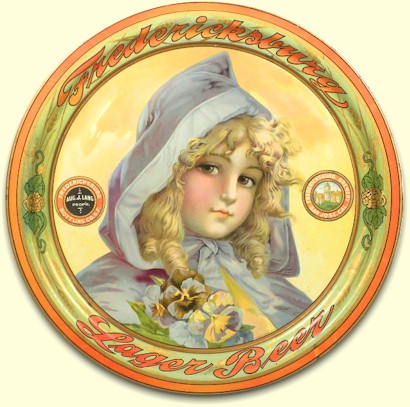|
The following is a vivid, first-hand account of a
brewery tour found in Pen Pictures from the Garden of the World,
published by the Pacific Press Publishing Co., Oakland, Cal., 1888.
"Embarking on one of the handsome cars of the
Electric Road we are whirled rapidly along the famous Alameda
Avenue, with its leafy shade, past the homes of wealthy men,
sheltered with giant trees and embowered in flowers, to a point
where stirring life and bustling activity proclaim the presence
of some great enterprise. It is the Fredericksburg Brewery, the
widest known and the most extensive establishment of its kind
west of the Rocky Mountains.
Immediately opposite is the Agricultural Park, where the annual
county fairs are held, and on every side are splendid private
residences, the home of culture
and affluence. The great pile of massive brick buildings that
make up this mammoth brewing establishment are very sightly in
their appearance. Fronting
on the grand thoroughfare of the Alameda is the reception hall,
as yet a modest structure, to be replaced in the near future by
a seemly building to correspond
with the great brick buildings beyond. It is flanked by a pretty
garden and a commodious hotel and refreshment saloon, each
feature being liberally patronized by those who enjoy the
bounties afforded and the beauties surrounding. Not far beyond,
and fronting on Cinnabar Street, which here meets the Alameda,
are the large and substantially handsome buildings devoted to
the various departments of the brewing business, three fine
two-story brick edifices,
from whose junction is now rising a lofty, commanding center, to
be, when finished, of three stories, constructed in the
strongest manner, and, as is shown by the plans (drawing
above), an elegant structure. It is the new brewhouse. In it
will be placed a new copper beer kettle, of a capacity of two
hundred and twenty-five barrels, also an iron mash tub with
copper bottom, an immense hop-jack, hot-water tanks, etc., all
of the best construction and manufactured by the George F. Ott
Copper and Iron Manufacturing Company, Philadelphia. In the
malt-house the curious visitor will see the enormous vats
wherein is soaked the barley, the vast stone cellars where it is
placed to sprout, the chambers for drying, and the mills for
grinding, some slight conception of the magnitude of all these
operations being obtained when it is remembered that seven tons
per day of barley are transformed into malt.
The engine-rooms next attract attention, where there is a row of
four huge boilers, and furnaces, supplying steam for the engines
needed to propel the
machinery of the establishment, its lifting, and pulling and
pumping, its mills, its elevators, and its enginery. There are
in all ten pumps, all necessarily of great power, employed in
the establishment, forcing the beer in the different stages of
its manufacture to the various parts of the building. Pure
artesian water is supplied from two artesian wells. One of the
most interesting departments is the refrigerator room, where two
engines of forty-horse power each are kept busy in the
manufacture of ice, the capacity being over fifty tons per day,
and in forcing salt water, cooled beneath the freezing point of
fresh water, through the storing rooms. The pipes containing
this water are enveloped in a constant coating of ice,
presenting a strange appearance as one comes upon them after the
genial atmosphere of out-of-doors, or the torrid heat of the
engine-rooms. The storage cellars present a sight that will not
be easily forgotten, range after range of giant tanks and vats
and casks, containing each from thirty-five to two hundred and
fifty barrels of beer. The fermenting room, with its long line
of frothing vats, when the beer is preparing for the storage
cellars, the filters, the great ocean of cooling ship — but why
attempt to describe the indescribable? It must be seen to be
appreciated, and in despair we abandon the attempt to picture in
detail.
After inspecting the main departments the visitor will not
easily tire of going through the bottling, and washing, and the
packing-rooms, the cooperage shops,
watching the curiously capped bottles that are under-going the
process of Pasteurization, the exquisite finish of the clear and
beautiful Pilsener and Culmbacher lager beers prepared for
export; and after it is all over he will quaff with a new
appreciation the nectar of the crystal clear and wholesome beer
presented at the hand of the genial F. A. Baumgartner¹, the
foreman who has done the honors of the establishment by
accompanying him through.
These latter departments occupy commodious wooden buildings
distinct from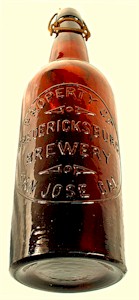 the main brewery, and are admirably fitted. To help the
imagination, it must be known that from eight thousand to ten
thousand bottles per day are required, these bottles being made
some in Illinois and some in Germany²
(right), and the annual production has risen from the
very small beginning made in 1869, to a grand total of
fifty-three thousand barrels from May to May last year, and a
probable sixty thousand during this present year, ending 1889.
In all some one hundred and twenty men, women, and children find
employment, the wages paid and the hours of work having always
been eminently satisfactory. In San Jose fifteen horses are
needed for the wagons, and a like number are used in connection
with the San Francisco business. The brewery is connected
directly by an independent switch with the Narrow Gauge Railway,
a material advantage when it is considered that shipments upon
an immense scale are required to fill the growing demands from
Central and South America, Old and New Mexico, Japan, Australia,
the Sandwich Islands, and the most distant portions of the
Pacific Coast States and Territories, in addition to the large
and firmly established local trade.
the main brewery, and are admirably fitted. To help the
imagination, it must be known that from eight thousand to ten
thousand bottles per day are required, these bottles being made
some in Illinois and some in Germany²
(right), and the annual production has risen from the
very small beginning made in 1869, to a grand total of
fifty-three thousand barrels from May to May last year, and a
probable sixty thousand during this present year, ending 1889.
In all some one hundred and twenty men, women, and children find
employment, the wages paid and the hours of work having always
been eminently satisfactory. In San Jose fifteen horses are
needed for the wagons, and a like number are used in connection
with the San Francisco business. The brewery is connected
directly by an independent switch with the Narrow Gauge Railway,
a material advantage when it is considered that shipments upon
an immense scale are required to fill the growing demands from
Central and South America, Old and New Mexico, Japan, Australia,
the Sandwich Islands, and the most distant portions of the
Pacific Coast States and Territories, in addition to the large
and firmly established local trade.
This great business was inaugurated on a very small scale in
1869, and has steadily prospered, until now, under the efficient
management of its proprietors, Messrs. Ernst Schnabel and Ernst
A. Denicke, the business is unsurpassed, Mr. Schnabel is the
manager of the brewery at San Jose, and his watchful oversight
the direct cause of the purity and excellence of the beer, while
Mr. Denicke resides in San Francisco and manages the outside
business. They possess ample capital, and, backed as they are by
long and successful experience, and untiring energy, the
Fredericksburg Brewing Company constitutes one of the most
important commercial institutions of the State."
Prior to 1890 the bottling shop had to be (as stated above)
"distinct from the brewery." The bottling works handled the bottling
of beer for export to foreign countries, and for local consumption.
Beer destined for other west coast markets was sent in kegs to local
agents who distributed the beer that they bottled, or had bottled by
a separate plant.
After 1890, the practice of using a bottler
continued, since the bottlers were also distributors and the
breweries didn't have to bear the expense of adding bottling works
and finding other distribution agents. However, many did add
bottling shops and did their own local distribution.
But there was one San Francisco bottler in the early 1890s that
chose profits over ethics.
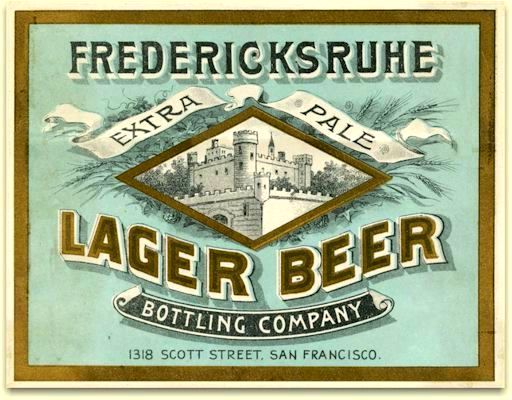
While it's said that immitation is the sincerest form of flattery,
Fredericksburg was not flattered and took legal action. the
April 1894 issue of Pacific Wine and Spirit Review reported that the
company had secured a perpetual injunction against W. Werdner, John
Kruger and others, restraining them from using "Fredericksruhe"
labels for beer, which were made to imitate the well-known
"Fredericksburg."

Embossed beer bottles usually gave the name of the bottling works so
that they would get the bottles back to be re-used, but the name was
also to be found on the label. In San Jose, the primary bottler of
Fredericksburg beer was Charles Maurer's San Jose Bottling Co. -
first Maurer Bros. and then later,
C. Maurer & Sons.

The use of bottler/agents continued until national Prohibition put a
stop to everything. Some of the other west coast bottlers were: the
Oakland Bottling Co. in Oakland, Cal. (above); J. R. Luttrell
& Son, San Diego, Cal.; H. Loose in Lovelock, Nev.; C. E. Roos
in Seattle, Wash.; Hoefer & Mevius in Redding, Cal.; H.
C. Heidtmann in Reno, Nevada; Kalamath Falls, Ore. (below);
Postel & Schnerr, and later
C. Schnerr & Co., both in Sacramento, Cal. (below).
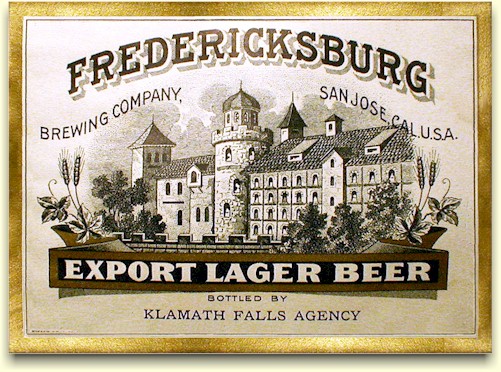
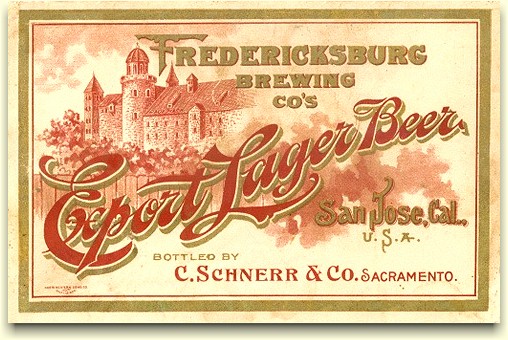
Upon completion of the 1888 brewery expansion, the brewery was
adorned with impressive spires and crenellated turrets. It looked
more like a German Rhine castle than the brewery envisioned in the
architect's plans (shown above). These distinctive architectural elements
became the brewery's trade mark, and appeared on their labels,
letterhead, and all other promotional material. The style was also
adopted by the Lang Bros. when they built their bottling works in
San Francisco, which would suggest that the Fredericksburg brewery
was a principal in the bottling plant.
San Francisco Breweries, Ltd.
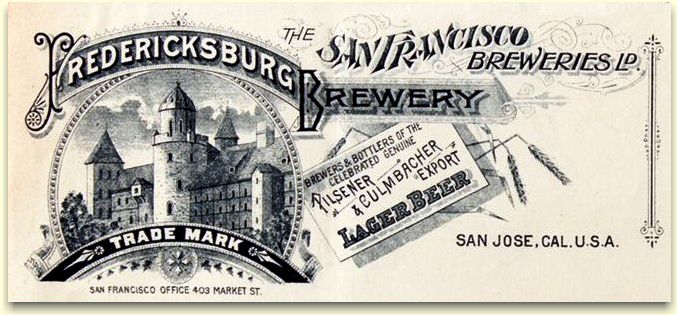
In 1890, controlling interest in the Fredericksburg Brewery was
purchased by San Francisco Breweries, Ltd. This British syndicate
was formed to acquire and amalgamate ten breweries in and around San
Francisco. The combine consisted of the Fredericksburg Brewery of San Jose; the Hofburg Brewing
Co. of West Berkeley; the Oakland Brewery, and Brooklyn Brewery,
both of Oakland; the John Wieland Brewery, Pacific Brewery, Chicago Brewery,
South San Francisco Brewery, United States Brewery, and Willows Brewery - all of San Francisco.
By 1899, four of the breweries had been liquidated: Pacific,
Oakland, Hofburg, and So. San Francisco. Of the six
remaining, the San Francisco fire and earthquake of April 1906, destroyed three:
Chicago, United States, and Willows. The remaining three in the Syndicate
was
Fredricksburg, which lasted until 1918; with both John Wieland and the Brooklyn
lasting until 1922.
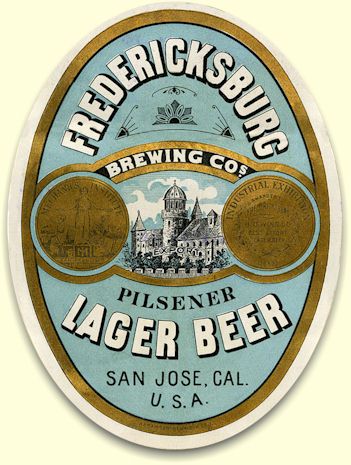
San Jose Bottling Co. ca.1895

crown cap lifter with
Prest-O-Lite Key²
Pat. 1901
A major fire broke out at the Fredericksburg Brewery in 1902 and the
great, six-story turreted tower of the malt house crashed into
Cinnabar Street. The brewery was rebuilt by the time of the 1906
earthquake and survived with only minor damage.
The post earthquake rebuilding in San Francisco brought other
changes to the cities breweries. They were now updating and
installing their own crown cap bottling lines, and the beer bottling
unions were demanding the end of embossed bottles and the use of
patented stoppers.
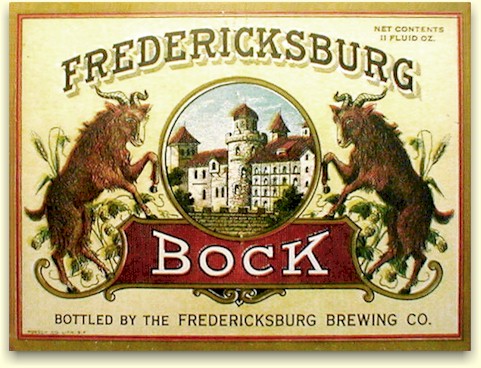
It's not clear which happened first, but in May of 1912, the
Fredericksburg Brewing Co. announced that their beer was now
"bottled by the brewery" - not
at the brewery, but by the brewery, which would indicate that
they were now the proprietors of the Fredericksburg Bottling
Company.

Also in May of 1912, August Lang & Co. released their own "Red Lion
Beer" from the
Aug. Lang Brewing Assn. at Baker & Geary Sts. Lang may have sold
to S. F. Breweries, Ltd. to fund the refit his newly acquired
brewery. The bottling works continued operating as the
Fredericksburg Bottling Co. until late 1918.
The Fredericksburg Brewery didn't quite make it to Prohibition in
1920. Due to a WWI
conservation effort limiting the alcohol level in beer, which was actually a thinly veiled prohibition
movement, most breweries elected to shut down. So in September of 1918, the
Fredericksburg Brewery ceased operations.
In 1922 the owners of the brewery, San Francisco Breweries,
Ltd., entered bankruptsy proceedings
and sold there three remaining breweries. Fredericksburg was
ultimately purchased by an investimate group headed by Charles
Henry Colpe of San Francisco. Plans for the San Jose plant
failed to materalize and it remaind shuttered.
In February, 1933, the Pacific
Brewing and Malting Company of San Francisco, filed articles
of incorporation with the Secratery of State at Sacramento. Its
capitalization was placed at $2,000,000. The directors named in
the articles were the former owners of the
Tacoma Brewing
Company, Charles H. Colpe, Henry E. Monroe, H. W. Steineggner,
J. M. Early, and W. J. Wilson, all of San Francisco.
The new company
re-opened the Fredericksburg brewery and malthouse, and in April
of 1933, commenced operation as
Pacific
Brewing & Malting of San Jose - with Fredericksburg Beer as
their flagship brand. Their brewmaster, was Louie Bumgartner,
son of their Pre-Prohibition era brewmaster, Frank. In 1906
Louie succeded his father as plant superintendent.
FOOTNOTES:
¹ Frank Aolis Baumgartner was born
in Bohemia in 1853. By 1880 he was a brewer in Chicago, but soon
thereafter left for California where he found a position with
the Fredricksburg Brewery.
²
Similar bottles to the one shown above were used by the Claussen-Sweeney
Brewing Co. and the
Bay View Brewery, but with green glass. This
confirms what has long been suspected by collectors - that these
bottles were made by the Siemens-Glaswerks of Dresden, Germany,
the largest bottle manufacturer in Europe at the time (ca.1887).
The
Fredericksburg Bottling Co. quart, in
green, is also believed to have been made in this Dresden glass
factory, but at a later date.
³
The Prest-O-Lite key is the square hole in the at the end of
the cap lifter which was used as a wrench to open the valve on
carbide tanks mounted on the running boards of early autos.
Headlights were illuminated by carbide gas from about 1900 to 1915.
|
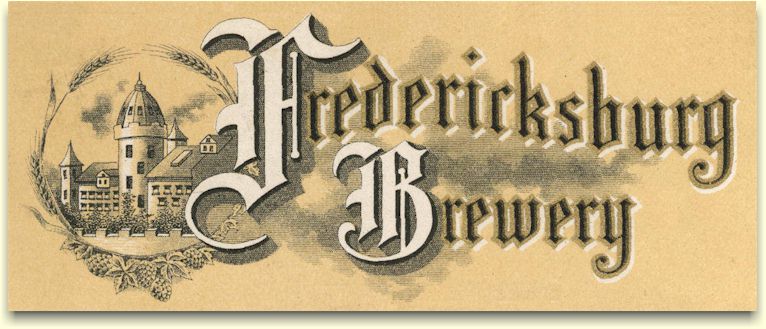


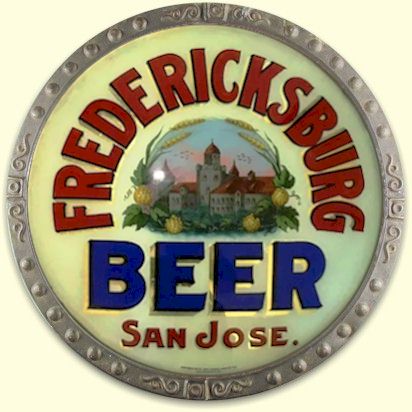
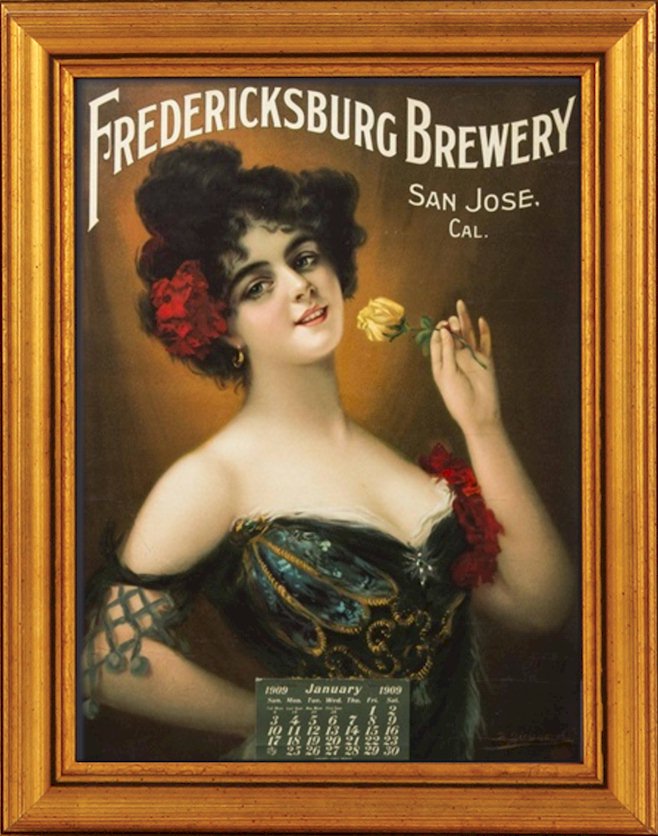

![]()
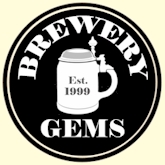
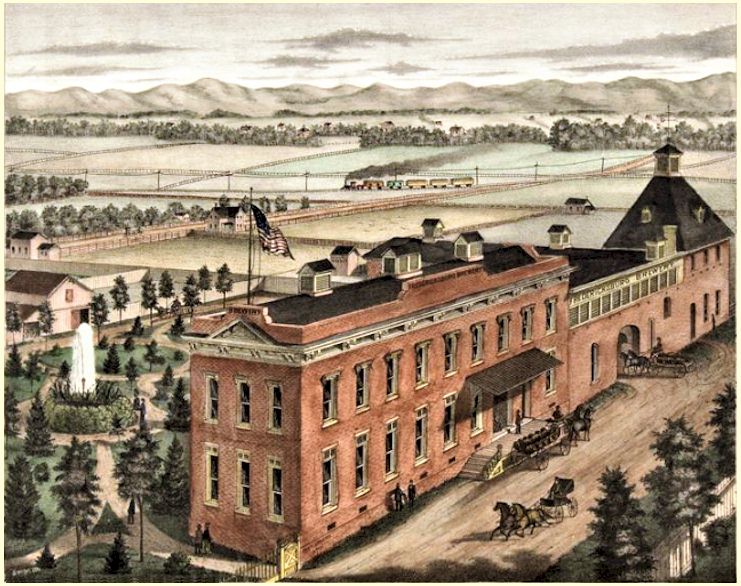
 the main brewery, and are admirably fitted. To help the
imagination, it must be known that from eight thousand to ten
thousand bottles per day are required, these bottles being made
some in Illinois and some in Germany
the main brewery, and are admirably fitted. To help the
imagination, it must be known that from eight thousand to ten
thousand bottles per day are required, these bottles being made
some in Illinois and some in Germany










